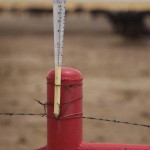All Signs Point to Strong Hurricane Season

Photo by NOAA
Hurricane Sandy strikes the East Coast on October 28, 2012. Forecasters are predicting an active hurricane season this year.
Tomorrow marks the beginning of the six-month Atlantic hurricane season, and forecasters think it might be a doozy.
The National Oceanic and Atmospheric Administration (NOAA) predicts this coming season will produce more than 13 named storms. An average season produces 12, but the amount of hurricanes and major hurricanes is predicted to be above average as well.
Dr. Gerry Bell, lead seasonal hurricane forecaster at NOAA says this summer will have at least two of the three main factors that lead meteorologists to predict a strong season.
“The first is a pattern that has been in place since 1995 and has produced a lot of hurricanes in the Atlantic since 1995,” Bell says. “It produces things like weaker wind shear, much more conducive winds coming from Africa, warmer Atlantic Ocean temperatures.”
Bell says scientists also study the fluctuating temperatures of the Atlantic and the El Nino and La Nina cycle. He says El Nino typically suppresses many hurricanes from forming or gaining strength.
“As far as predicting an active season, we’re usually pretty accurate at that,” Bell says. “Last year we under-predicted the season strength because all the climate models predicted El Nino to form, but it didn’t.”
“With the devastation of Sandy fresh in our minds, and another active season predicted, everyone at NOAA is committed to providing life-saving forecasts in the face of these storms,” NOAA Acting Administrator Dr. Kathryn Sullivan said in a statement.
Even with the factors that help predict what type of season lies ahead, Bell says forecasters can’t estimate where or even if the storms will make landfall just yet.
“Where, when, how strong when they make landfall are really controlled by weather patterns when they approach, which aren’t predictable but a week in advance,” he says. “But historically, there is a very high likelihood for multiple hurricane strikes in the U.S.”
Bell stressed that many hurricanes have an impact beyond the coastline. He said heavy rains and strong winds associated with the storm can effect areas hundreds of miles inland.
But, as National Weather Service Southern Region climate program manager Victor Murphy has pointed out in the past, it could take an event as severe as a hurricane to pull Texas out of the continuing drought.
When the Atlantic storms form, the monikers they will acquire will come from a list of 21 names maintained by the World Meteorological Organization. Most of the names on the list were used during the 2007 season, and will be used again in 2019. Storms causing notable damage have their names replaced on future lists.
Hurricane Barbara, which recently made landfall on Mexico’s Pacific coast, is the second storm in this year’s Pacific Hurricane Season, which started May 15, but rarely affects North America.

